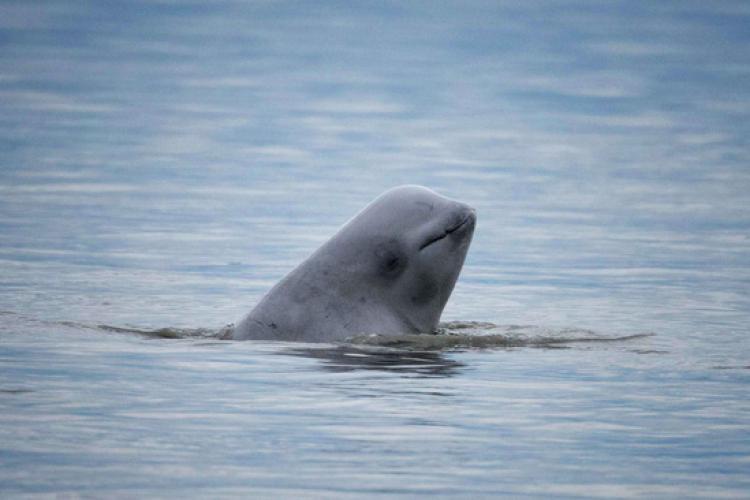Environmental Groups Respond to Department of Energy’s Approval of Alaska LNG Project
Approval greenlights another carbon bomb, one of the largest U.S. infrastructure projects ever proposed
Contact
Today, the U.S. Department of Energy (DOE) announced it would grant approval for the exports from the proposed Alaska LNG project, a $38.7 billion fossil-fuel infrastructure plan to export liquified natural gas (LNG). It would be capable of exporting 20 million metric tons of gas per year — a quantity that could result in over 50 million metric tons of carbon dioxide pollution emissions annually.
Earthjustice is currently representing environmental groups in challenging another key approval for the Alaska LNG project by the Federal Energy Regulatory Commission (FERC).
With DOE and FERC approvals, the Alaska LNG export terminal now has most of the approvals needed for it to move forward. The ultimate fate of the project, however, is far from certain. The DOE order also grants the Center for Biological Diversity and Cook Inletkeeper leave to intervene, clearing the way for both organizations, along with Sierra Club, to potentially file additional legal challenges to DOE’s approval. Earthjustice has represented the Center for Biological Diversity and Cook Inletkeeper to date in Alaska LNG proceedings before DOE.
The following statements were issued in response to DOE’s approval:
Erin Colón, an Earthjustice senior attorney based in Juneau, Alaska, who led the FERC litigation: “Not only is the Alaska LNG project unnecessary given the widespread transition to clean-energy alternatives we expect to see in the years to come, it’s also a major threat to ecosystems and climate in Alaska. The state’s greenhouse gas emissions from fossil fuels would balloon by nearly 30% over today’s levels, in an era where all other states will be scrambling to reduce greenhouse gas emissions. This is also happening in a place that is uniquely impacted by climate change — with sea-ice melt, thawing permafrost, and coastal erosion. It’s frustrating to see the Department of Energy rubber-stamp a massive fossil-fuel infrastructure project of this kind when it clearly conflicts with the urgent need to tackle the climate crisis.”
Andrea Feniger, Sierra Club Alaska Chapter Director: “The proposed Alaska LNG export project would threaten Arctic wildlife and exacerbate the climate crisis by locking in decades of increased gas extraction and exports at a time when the science is clear that we must rapidly transition away from fossil fuels. Claiming that a project like this could possibly be in the public interest isn’t just out of step with the Biden administration’s stated commitment to climate action — it’s out of step with reality. We will pursue every available avenue to ensure that this ill-advised project is never built.”
Liz Jones, an attorney at the Center for Biological Diversity’s Climate Law Institute: “Right after the horrific Willow decision, it’s painful to see Biden officials greenlight an even bigger fossil fuel project that will destroy Arctic habitat and feed the climate crisis. This project will send billions of cubic feet of gas a day across Alaska and through waters teeming with wildlife, all to be burned up on foreign shores into our overheating atmosphere. The Alaska LNG project should never have been approved.”
Moneen Nasmith, a Senior Attorney in Earthjustice’s National Climate team: “Over its 30-year minimum lifespan, DOE’s own numbers confirm that the project will contribute over 2 billion tons of greenhouse gas emissions, which will undercut many of the gains the Biden administration has proposed to curb emissions, and could emit as much as ten times more carbon into the air than the massive Willow Project. The condition DOE added on venting may prevent even greater amounts of emissions from producing the massive amounts of gas needed to supply the project, but represents a small fraction of the overall emissions the project will cause. This administration cannot continue to approve these fossil fuel projects and say that it is taking the climate crisis seriously.”
Background
Proposed by the Alaska Gasline Development Corporation (AGDC), an Alaska state-owned corporation, the project involves constructing an 807-mile pipeline that would bisect the state from north to south, spanning a distance roughly the width of Texas. Construction would affect 35,474 acres of land, 45% of which would be permanently affected. “Stranded” gas deposits discovered decades ago in Alaska’s Arctic, which would remain in the ground without causing any climate harm if it weren’t for this project, would first be extracted and sent to gas treatment facilities operated by AGDC in the Arctic. The gas would then be transported 807 miles south to the Kenai Peninsula via the new pipeline, which would require 489 new roads to construct and maintain. AGDC would also build a liquefaction plant and marine terminal on the eastern shore of the Cook Inlet in Nikiski. The LNG would be transported to Asian markets via Cook Inlet, a sensitive water body that offers critical habitat for endangered beluga whales.
AGDC estimates that the Alaska LNG project will export 20 million tons of LNG per year, with some also tapped for in-state use. However, interest in gas will be waning by 2030, the earliest AGDC could expect to begin exporting LNG. The four countries that DOE assumes would receive gas from the Project — Japan, South Korea, China, India — all have announced plans to expand their renewable energy usage. By the year 2030, the IPCC warned in its Sixth Assessment Report, nations must complete the task of slashing greenhouse gas emissions 50% below pre-industrial levels. By the time this project would be built, there may no longer be any demand for it, leaving more stranded fossil fuel infrastructure across the state.

Additional Resources
About Earthjustice
Earthjustice is the premier nonprofit environmental law organization. We wield the power of law and the strength of partnership to protect people's health, to preserve magnificent places and wildlife, to advance clean energy, and to combat climate change. We are here because the earth needs a good lawyer.